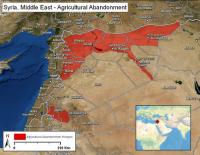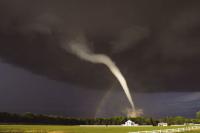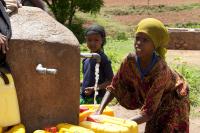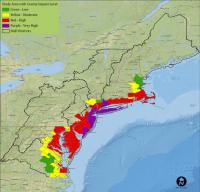-
Are America's cities prepared for extreme weather events?
Infrastructure is, by design, largely unnoticed until it breaks and service fails. It is the water supply, the gas lines, bridges and dams, phone lines and cell towers, roads and culverts, train lines and railways, and the electric grid; all of the complex systems that keep our society and economy running. Engineers typically design systems to withstand reasonable worst-case conditions based on historical records; for example, an engineer builds a bridge strong enough to withstand floods based on historical rainfall and flooding. But what happens when the worst case is no longer bad enough?
-
-
Senior defense officials discuss arctic, Antarctic science and research
To address the need for collaborative research in the Polar Regions, Chief of Naval Research Rear Adm. Mat Winter met in Finland two weeks ago with counterparts from five nations in a first-ever gathering of senior defense officials to coordinate science and technology research in high latitudes. While the U.S. Navy has long experience with polar operations, changing climates present new challenges — particularly for surface ships, as new water passages open up.
-
-
Impact of climate change on agriculture may be underestimated
Studies of how climate change might affect agriculture generally look only at crop yields — the amount of product harvested from a given unit of land. But climate change may also influence how much land people choose to farm and the number of crops they plant each growing season. A new study takes all of these variables into account, and suggests researchers may be underestimating the total effect of climate change on the world’s food supply.
-
-
Seeding iron on the Pacific’s floor may not pull carbon from air as thought
Scientists plumbing the depths of the central equatorial Pacific Ocean have found ancient sediments suggesting that one proposed way to mitigate climate warming — fertilizing the oceans with iron to produce more carbon-eating algae — may not necessarily work as envisioned.
-
-
Syria’s 1998-2012 drought likely its most severe in more than 900 years

In the years before the Syrian conflict erupted, the region’s worst drought on record set in across the Levant, destroying crops and restricting water supplies in the already water-stressed region. A new study shows that that drought, from 1998 to 2012, was not just the most severe in a century of record-keeping — it was the Levant’s most severe drought in at least 500 years and likely more than 900 years.
-
-
Groundwater deficit growing in important western U.S. aquifers
By 2050, climate change will increase the groundwater deficit even more for four economically important aquifers in the Western United States, a new report says. Groundwater deficits are expected to worsen in four important aquifers, creating a precarious balance between usage and recharge. The new report is the first to integrate scientists’ knowledge about groundwater in the American West with scientific models that show how climate change will affect the region.
-
-
Outbreaks of extreme tornados have become more common

Most death and destruction inflicted by tornadoes in North America occurs during outbreaks — large-scale weather events that can last one to three days and span huge regions. The largest outbreak ever recorded happened in 2011. It spawned 363 tornadoes across the United States and Canada, killing more than 350 people and causing $11 billion in damage. A new study shows that the average number of tornadoes per outbreak has grown by more than 40 percent over the last half century. The likelihood of extreme outbreaks — those with many tornadoes — is also greater.
-
-
Climate change impact on food production could cause 500,000 extra deaths in 2050
Climate change could kill more than 500,000 adults in 2050 worldwide due to changes in diets and bodyweight from reduced crop productivity. The research, published yesterday in The Lancet, is the strongest evidence yet that climate change could have damaging consequences for food production and health worldwide. The study found that by 2050, reduced fruit and vegetable intake could cause twice as many deaths as under-nutrition, and that three-quarters of all climate-related deaths due to changes in food production are estimated to occur in China and India.
-
-
Water storage strategies in Sub-Sahara Africa

Direct abstraction of water from rivers through ponds and pumping devices seems the most attractive water storage option in Ethiopia. However, the funding agencies that may be interested in investing in such a storage system have to consider that better access to credit, and clear abstraction policies should be ensured.
-
-
Calculating monetary losses from floods caused by sea level rise
Damages from extreme events like floods are even more relevant than the mean sea level itself when it comes to the costs of climate impacts for coastal regions. However, while it is now rather well understood how sea-levels will rise in the future, only small progress has been made estimating how the implied damage for cities at the coasts will increase during the next decades. Scientists now provide a method to quantify monetary losses from coastal floods under sea-level rise. For the first time, the scientists show that the damage costs consistently increase at a higher rate than the sea-level rise itself.
-
-
Sea-level rise in twentieth century faster than in any previous century
Global sea level rose faster in the twentieth century than in any of the twenty-seven previous centuries, according to a new study. Moreover, without global warming, global sea level would have risen by less than half the observed twentieth century increase and might even have fallen. Instead, global sea level rose by about 14 centimeters, or 5.5 inches, from 1900 to 2000. This is a substantial increase, especially for vulnerable, low-lying coastal areas.
-
-
New tool for coastal planners preparing for sea level rise

Scientists have developed a new model to help coastal planners assess the risks of sea level rise. Put to use on a global scale, it estimates that the oceans will rise at least twenty-eight centimeters on average by the end of this century — and as much as 131 cm if greenhouse gas emissions continue to grow unchecked.
-
-
Experts tackle U.K. flood risk
The U.K. Blue-Green Cities Research Project combines the expertise of academics from nine U.K. universities plus partners in the United States and China specializing in flood inundation modelling, computation fluid dynamics, sediment debris processes, river restoration and habitats, urban drainage infrastructure, environmental economics, uncertainty, flood risk management, and stakeholder engagement. The project’s goal is to make U.K. cities more resilient to flooding.
-
-
Integrating markets to offset climate-related food insecurity
Global market integration is key to buffering future commodity prices and food security from the negative effects of climate change on agriculture. Rising temperatures and an increase in extreme weather events will likely have adverse impacts on global crop production, leading to higher food prices and food scarcity. But global markets that have the ability to deliver food where it is needed most could help offset these consequences.
-
-
Extreme weather likely to result in “food shocks”
A panel of British and American researchers, speaking at the annual meeting of the American Association for the Advancement of Science (AAAS) in Washington, D.C., presented updated research revealing how extreme events which affect the food system are increasingly likely to occur, resulting in “food shocks.”
-
More headlines
The long view
How Climate Change Will Affect Conflict and U.S. Military Operations
“People talk about climate change as a threat multiplier,” said Karen Sudkamp, an associate director of the Infrastructure, Immigration, and Security Operations Program within the RAND Homeland Security Research Division. “But at what point do we need to start talking about the threat multiplier actually becoming a significant threat all its own?”
